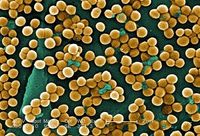Staphylococcus aureus: USA:300
A Microbial Biorealm page on the genus Staphylococcus aureus: USA:300
Classification
Domain: Bacteria
Phylum: Firmicutes
Class: Bacilli
Order: Bacillales
Family: Staphylococcaceae
Genus: Staphylococcus
Species: S. aureus
(Strain: USA:300)
Description and significance
Staphylococcus aureus: USA:300 is a strain of gram-positive coccus bacteria responsible for Methicillin-resistant Staphylococcus aureus (MRSA), or Staph infection in humans. This strain of S. aureus is resistant to β-lactam antibiotics. When cultured, this bacteria appears as golden clusters. The golden color is the result of a carotenoid pigment that protects the bacteria against host-immune system reactive oxygen species, and adds to the bacteria's virulence. S. aureus is a facultative anerobe, which can be found in a wide variety of locations such as soil, human skin, and public places like hospitals and prisons. This strain of S. aureus: USA 300 was first identified in 1998, and is thought to be the primary causal strain of community-acquired Staph infections throughout the United States, Canada and Europe. In 2006 the CDC reported that 64% of MRSA isolated from infected patients were of the USA 300 strain. This bacteria contains the cytotoxin Panton-Valentine leukocidin (PVL), which targets leukocytes. It also contains modulin, which is a phenol-soluble peptide (PSM) that is capable of lysing neutrophilic granulocytes. These toxins cause rapidly-progressing fatal conditions such as necrotizing pneumonia and faciitis and severe sepsis.
Genome structure
The genome of S. aureus: USA:300 was first sequenced in 2006. It contains a single, circular chromosome. This strain was found to have a genome of 2,872,769 base-pairs (bp) and 2,560 genes. It also contained a 3.1 kilobase (kb) plasmid and 27kb plasmid. As expected the genome contained genes encoding for the cytotoxins PSM and PVL, as well as an Arginine catabolic mobile element or (ACME) gene which is thought to have been acquired by USA:300 from S.epidermidis by horizontal gene transfer. The presence of ACME helps to explain the prevalence of Staph infections of the skin.
Cell structure, metabolism & life cycle
S. aureus: USA:300 is a facultative anaerobe, meaning that it is capable of aerobic respiration in the presence of oxygen, and in an anoxygenic environment can switch to fermentation. It utilizes the pentose cycle in carbohydrate breakdown, and glycolysis in glucose metabolism. It is not known to use the Entner-Doudoroff pathway. Interestingly, in iron-deficient environments, S. aureus has been found to redirect its central metabolsim to sequester nutrients, helping it to survive in hostile host environments.
S. aureus: USA:300 is a gram-positive bacteria, and contains a thick layer of peptidoglycan. The cell walls also includes murein, teichoic acids, and surface proteins. The murein layer is extremely complex and is composed of glycan and oligopeptide chains arranged in a plane perpendicular to the plasma membrane. The oligopeptide chains are thought to confer a "zig-zag" arrangement and the glycan strands are considered to be "zippering". Together, these form a macromolecular sacculus surrounding the entire cell. The surface proteins play a multitude of different roles. They contain a class of surface protein adhesions, known as MSCRAMMs which assist the bacteria in adhering to host-immune cells.
Ecology (including pathogenesis)
Describe its habitat, symbiosis, and contributions to environment. If it is a pathogen, how does this organism cause disease? Human, animal, plant hosts? Describe virulence factors and patient symptoms.
Interesting feature
Describe in detail one particularly interesting aspect of your organism or it's affect on humans or the environment.

